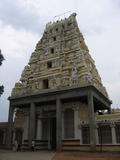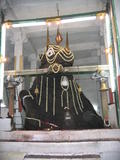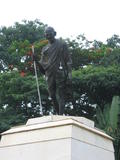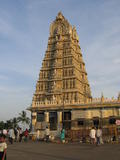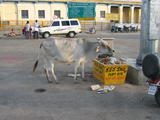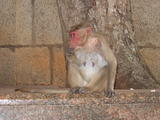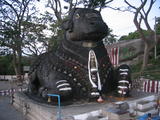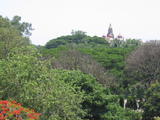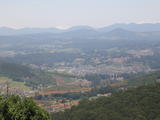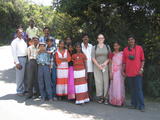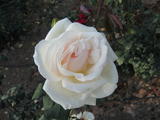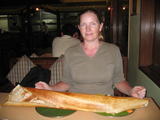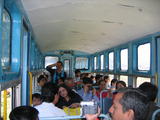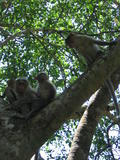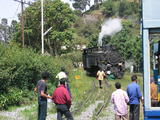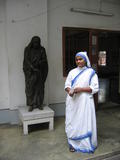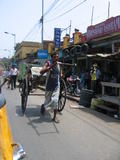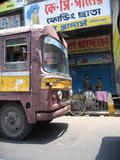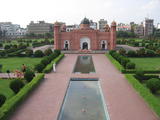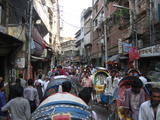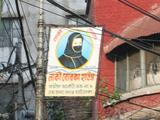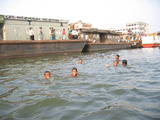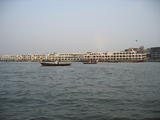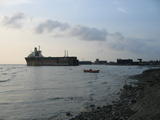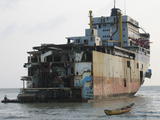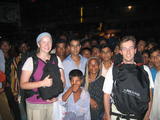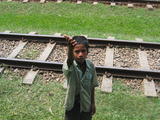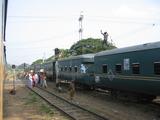| < < < Previous story | Next story > > > | |
India and BangladeshTallinn, 26 August 2005
Contents:Return to IndiaWe returned to India from the Maldives, landing in Bangalore, the heart of India's IT industry. The town is certainly better developed than Chennai and somewhat cleaner. For example there are many more restaurants, bars and pubs, that approach a western standard of cleanliness. However, traffic was nearly as chaotic and surprisingly, for an IT capital, there were many power cuts! In the last update I did not write about some of the first impressions we had of India when we arrived in Chennai. Here is one, Indians bob their head from side to side when they mean yes or "I understand". Initially we took it to mean "no", making an ass of ourselves explaining the same thing three times to the cab driver that took us from the airport, before Federico, another traveler who was sharing the cab with us told us what it actually meant. We had a good laugh. Indians often ask what your "good" name is. For example when calling ahead to a hotel, in an attempt to make a reservation, they will ask you what your "good" name is. Not that it helps because invariably when getting there, nobody will remember your "good" name, or have any clue about a reservation. Maybe they would remember it better if you gave your "bad" name? Bangalore left no big impression, there is not that much to see, except for the giant Nandi. This bull statue is one of the largest in India, it was also 468 years old (in 2005) according to the monk in charge, so it must have been built in 1537. However, he waved off popular belief that the statue had grown in size after completion as pure fiction. He told us that there are only 4 bull statues of comparable size in India. In nearby Mysore there are a few more interesting things to visit. Namely the City Palace (Amber Vilas) and Chamundi hill. The city palace is a nicely maintained and well worth a visit. Unfortunately cameras are not allowed inside. Chamundi Hill has nice views over Mysore. The hilltop temple is nothing special but a short walk down the hill there is another giant Nandi statue. This one dates from 1659. Ooty (now officially named Udagamandalam) was cooler due to its higher elevation at 2200 meters. This was a nice break from the otherwise warm and humid climate in southern India. In this season however many people try to escape the heat and head to the mountains, so it was very crowded. There is a scenic train ride through the Nilgiri Hills from Ooty to Coonoor and a steam train from Coonoor to Mettupalaiyam. It is a popular trip. Although we had heard many stories from other travelers about problems with food, we had none. Instead we found South Indian food to be quite delicious. Certain dishes are served on a banana leaf and you must eat them with your fingers! One day, while sitting in a road side restaurant, I observed a police officer call a traffic offender to him and watched bewildered as the officer slapped the offender in the face! Wow, that really brings home some cultural differences! Kolkata (Calcutta)After spending a short time in southern India, we wanted to go to the north, specifically to visit Bangladesh, Sikkim and Nepal (we later dropped Sikkim). Hence we chose to fly to Kolkata but this was not as easy as it first seemed. Most airlines in India discriminate against foreigners in their pricing structure. For example I saw a Jet Airways ad for a flight from Bangalore to Kolkata for 6940 Indian Rupees (approximately 155 USD) but I could not book it because I am a foreigner. Foreigners had to pay 290 USD. I felt offended. Why the difference? There are tens of millions of Indians that earn more money than the average foreign backpacker, and these are exactly the Indians that are flying! Fortunately a new airline appeared in the Indian skies last year, Air Deccan. When I logged on to their website I found a flight from Chennai to Kolkata for 2800 Rupees (approximately 63 USD) and no discrimination against foreigners whatsoever! Unfortunately the connecting flights where full, so we went to Chennai by train, in spite of my hope not to have to return there. A price difference of 227 US Dollars per person made it worth the effort. Competition can be great and it may eventually bring an end to discrimination against foreigners in the Indian skies. Kolkata's most famous resident must have been the late Mother Teresa. Somehow I had it in my mind that Kolkata must therefore be the most destitute city in India or maybe even on Earth. Although Kolkata is not clean by any western standard it is a lot cleaner (and greener) than Chennai for example, there also seemed to be fewer beggars. We were surprised. There is even a small backpacker hotspot in the area around Sudder Street, with many hotels, restaurants, Internet cafes and bookshops. There are many power cuts though, the last two days that we spent in Kolkata the power was simply never on. Shops and hotels had their own generators. We also visited Mother Teresa's tomb, which is starting to become a tourist attraction of its own. Her tomb is in a room on the ground floor of her mission. On the walls stories and photos expose her life. Some of them carry peculiar quotes from her such as this one: "The poor are the most precious gift of God to us - Jesus' hidden presence." What can you say? India has clearly been blessed with a larger share of this precious gift than most countries, so she came to the right place to find Jesus... Bangladesh, been there, done that!Curiosity and a country race obliging, we just had to visit Bangladesh, fortunately it is possible to apply for a visa at the Bangladeshi consulate in Kolkata and collect the visa on the same day. While applying for the Bangladeshi visa we met Mark, an Australian traveler, together with whom we took the bus to Dhaka the next day. Once in Dhaka, we found what was probably the most chaotic city we have visited so far. They drive like crazy, which happens in many developing countries, but in Bangladesh it is just a little more extreme! No vehicle stops for traffic lights when they are red, not even when a policeman is standing at the crossing. Once two friendly policemen helped us cross a street when the light was green for pedestrians, shouting and yelling at cars, busses and trucks to stop! Another time we nearly got run over by a speeding bus, who clearly had not a care in the world for pedestrians. During the few days that we spent in Bangladesh, we witnessed the aftermath of 2 serious accidents involving busses and trucks. We were also involved in a rickshaw "accident" when our driver simply squeezed a pull cart between his vehicle and a bus. Instead of moving backwards to dislodge his rickshaw he kept trying to go forward and eventually managed to pull loose, doing much more damage to the vehicles involved, including fortunately to his own. He then sped off, shaking his head complaining how stupid the other drivers were... sure. Besides total traffic chaos, the city is awash with beggars. It was a rather shocking experience as they were unfortunately much more persistent than in India, following you street after street. Some beggars were literally throwing themselves on the ground in front of us, crawling towards us holding one hand up! Annoyingly many beggars, covered with layers of dirt and possibly infected with all kinds of diseases, touch you to try to get your attention. Sometimes it became too much, we had to physically push them away or ask a nearby cop (there were many) to send them away. The major sight in Dhaka is Lalbagh Fort, a little peaceful oasis inside the city consisting of a few ancient buildings in a well groomed garden surrounded by a fortification wall. Then there is Sadarghat, a point on the river where all the boats from around Bangladesh seem to convert to. There are chaotic scenes both on land and on water. We got ourselves a short trip on the river, only to see how young boys jumped into the water to swim to our boat and ask for money. A lot of Bangladeshis ogle at fair skinned girls and they are not very subtle about it either. While in the train to Chittagong, a guy stood in the doorway staring at Maris for several minutes. Subtle remarks, such as "thank you and good bye" had no effect so after a few minutes I got up and slammed the door shut in front of his face. As a foreigner one invariably attracts a lot of attention in Bangladesh probably because there are not very many foreigners. For us it already started at the border, where the head of the border guards just wanted to talk with us when he heard that we had entered the country. In many places whole groups of people aggregated to take a look at us as if we were famous. Some Bangladeshis go out of their way to help foreigners. Mark had brought up the subject of the ship-breaking yards, just north of Chittagong. I remembered seeing a TV report about it many years ago, so thought that it was an interesting idea. Not wanting to needlessly risk our lives on Bangladeshi roads we took the train to Chittagong, from where we took a rickshaw to the yards. Unfortunately no guard would let us in, all referring to orders from their bosses. Apparently too many western journalists have visited the yards and wrote bad reports about the working conditions. But we just had to see it. Fortunately Maris managed to convince one guard to let us in. From inside one of the yards, we saw several ships that were beached and half torn up. It is an interesting sight. No-one was working while we were there as it was Friday, the Muslim holiday, so we were not able to witness those appalling working conditions for which the yards have become known. We returned to Dhaka by train, this time we saw kids train surfing, they were jumping from the roof of one train carriage to the next while the train was moving. They were doing this continuously, once on the next carriage they turned around to jump back on the carriage they came from. Seems like a particularly dangerous way to kill some time! In the train, a constant trickle of beggars passed, some crawling along the floor with open wounds! At stations beggars aggregated outside of the windows. Our main objective however in this part of the world was to see the Himalayas and we could not wait to get to Nepal. Several airlines fly from Dhaka to Kathmandu, but because of Bangladesh' absurd visa restrictions we had to leave through the border crossing indicated in the visa and therefore had to take the bus back to Kolkata. We picked up an English language newspaper on the bus, one article caught my attention, it was that of a traffic accident, apparently a female student had been killed by a speeding bus while on her motorcycle near Dhaka university. The bus continued on its path, drove through a red-light (nothing unusual in Bangladesh) and hit a few pedestrians. The police, which had a booth at this junction had apparently never made any effort to control traffic. This caused enraged students to set the bus on fire and attack the police booth in question! Next the police "retaliated" by entering the university, beating up anybody they could find and ransacking the building! 50 students were injured in this raid. After being to Bangladesh, nothing in this story really surprised me. When I asked Mark if he would ever return to Bangladesh, he answered in his typical colorful Australian fashion: "I've got more chance of rubbing me arse on the moon!" If you would like to be notified or no longer want to be notified of our travel updates please e-mail me. e-mail Otto de Voogd PhotosBangaloreMysoreOotyKolkataDhakaChittagongPractical Information
To my knowledge the information provided here was accurate
at the time of our visit. However time passes and things can change.
Visas
India: from Indian embassy in Yangon:
65 USD (40 USD + 25 USD for telex) the process takes one week.
The embassy in Yangon is a good place to apply. As not many people apply
there so we never had to wait a long time.
Money
India: Many, but not all, ATMs work with foreign cards.
Cash US Dollars in small denominations are useful to pay entrance fees to
government controlled sites as the price in Indian rupees is some 20% higher.
Travel
Airlines: Only one airline does not discriminate against foreigners:
Train:
InternetAll over India it was generally possible to find a cheap Internet cafe with a fast connection. In Bangladesh we encountered Internet access only once in a hotel in Chittagong which was quite fast and affordable. Bookshops
Bangalore: Premier Bookshop on Church Street has many English language books crammed in every possible space in the small shop. Including some travel guides.
CostsIndia - Rupee, approx. rates: 1 USD = 44 INR, 1 EUR = 56 INR
Prepaid airport taxi to Bangalore center (Brigade Road): 180 INR
Bangladesh - Taka, approx. rates: 1 USD = 64 BDT, 1 EUR = 80 BDT
Dhaka: Hotel Royal Palace: 1350 BDT, incl 5% service charge. a/c, sat-TV,
bathroom, warm water.
India - Rupee, approx. rates: 1 USD = 43.50 INR, 1 EUR = 54 INR
Kolkata: Hotel Gulishan Palace: 700 INR incl. tax. a/c, bathroom, warm water,
sat-TV. Got a group discount (together with fellow travelers we took 3 rooms).
Normal rate 780 INR.
| ||
| < < < Previous story | Next story > > > | |
New | About | Contact | Connect | Friends | Promotions | Copyright | Advertise
